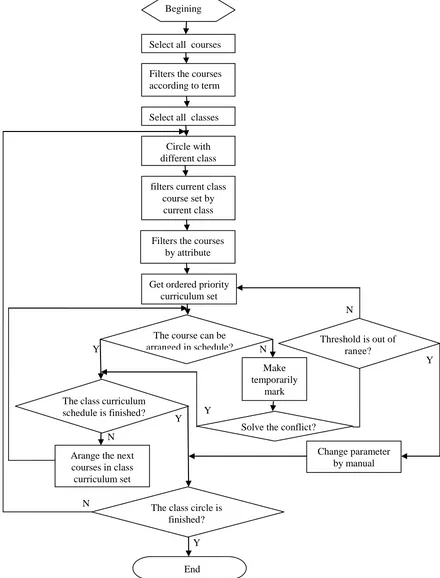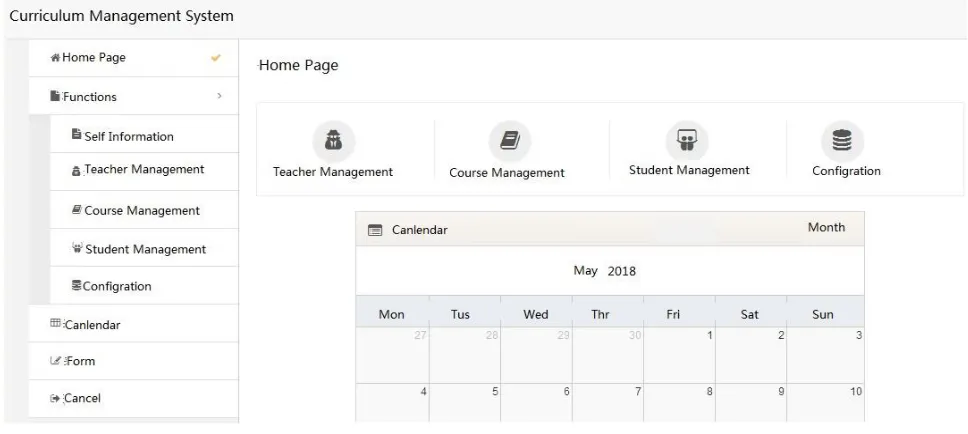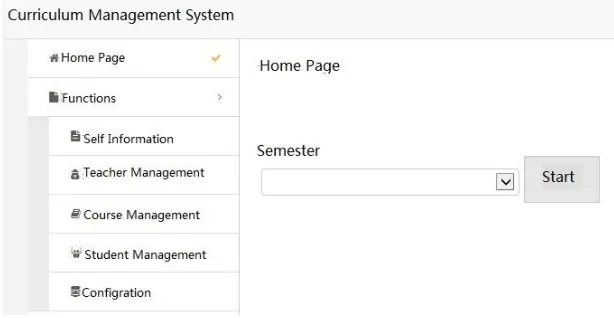2019 International Conference on Information Technology, Electrical and Electronic Engineering (ITEEE 2019) ISBN: 978-1-60595-606-0
The Research of Curriculum Management Information System in
Colleges and Universities
Cheng-xia LIU* and Min-ling ZHU
Computer School, Beijing Information and Science University, Beijing, China
*Corresponding author
Keywords: Information technology, Curriculum management, Educational administration management, Curriculum arrangement.
Abstract. With the development of information technology, the educational administration in Colleges and universities is more and more inclined to paperless and automated. How to carry out curriculum management is an indispensable part of educational administration management. On the basis of studying various curriculum management systems at home and abroad, this paper puts forward an curriculum arrangement based on priority strategy, which can select the optimal curriculum arrangement among various schemes and deal with conflicts optimally, thus improving the efficiency of curriculum arrangement and students' curriculum selection by school educational administration departments. Finally, the prototype system of the course management system is implemented based on JAVA, which facilitates the retrieval and management of courses by managers, teachers and students.
Introduction
With the development and progress of information technology, how to carry out information-based teaching management system has become an urgent task. Because the center of teaching is the courses teaching, so how to arrange the curriculum reasonably has become the top priority.
At present, the information-based curriculum management system has emerged in endlessly stream. Many products are developed by companies abroad, such as Blackboard[1] , WebCT and Desire2Learn . Teachers can manage courses, make courseware, assign homework and communicate with each other by using these. But they are commodity software, and they need to be paid annually according to the number of users and the annual fee, which limits its in-depth promotion. There are also some open source course management systems, such as ATutor[2], Claroline[3], Sakai, Dokeos[4], Moodle[5], Bodington, and so on, each of them has its own advantages and scope of application. Generally speaking, due to the differences in education at home and abroad, many of them are not suitable for domestic university curriculum management.
Requirement Analysis and Design of Curriculum Management System
System Functional Requirement Framework
[image:2.595.70.506.181.323.2]In order to realize the paperless information management, this paper puts forward a suitable curriculum management system scheme based on the research of curriculum management in colleges and universities. The system is divided into three modules, including management module, student module and teacher module, as shown in figure 1.
Figure 1. Function module diagram of curriculum management system.
Each management module can increase, modify, delete, and query the corresponding information. In the course management sub-module, the automatic course scheduling function is also realized. Let's look at how to achieve automatic course scheduling.
Design of Course Scheduling Scheme Based on Priority Strategy
At present, there are many studies and strategies on how to arrange courses in the educational administration system[6-8]. Here we adopt a relatively simple, priority-based strategy for arranging courses. The system first selects all courses, filters the course data according to the term conditions passed from the page, and obtains the required course set. Then selects all the classes, and filters the current class course set according to the current class, and after that extracts the current class course number by cycle. According to the attributes, which is "required" and "optional", get the collections of compulsory courses and optional courses. Then the teaching hours are extracted from each of the two collections of courses, and the number of classes required per week is calculated. A priority entity of courses is encapsulated by all the factors above. Then, according to the priority of courses from high to low, the priority courses of compulsory courses and elective courses are sorted separately, and the priority courses are sorted in descending order, respectively. Finally, the priority courses of compulsory courses and elective courses are sorted in descending order. Finally, the priority courses of compulsory courses and elective courses are sorted in descending order. Take two ordered priority curriculum sets to arrange courses, circle the ordered priority curriculum set, and then take out the priority curriculum in the set in turn. According to the priority of priority curriculum, we know the number of lessons per week of priority curriculum, and then arrange courses according to the number of lessons. First, we make class judgment on the course, whether we can find a position in the class, and judge whether it is a priority curriculum. Then, make a teacher's judgment on the course base on whether the teacher has class or not during the course time. If judge success, then judges the classroom based on whether the classroom has class or not during the course time. If all the judges are success, the course schedule is successful.
In this process of scheduling, if the teacher of one course already has another course at the same time, which we call it as teacher conflict, the position in the schedule will be temporarily marked as having a class, and the course will be rearranged. If it is still impossible to arrange the course in the schedule, then put the unscheduled course to the first place of the ordered priority curriculum set and get the reordered priority curriculum set. The whole process of scheduling will be restarted. If there is
Curriculum management system
Management Module (student management, Teacher
management and Course management,etc.)
Teacher Module (Information search, Score
management,etc)
Student Module (Course selection and Score
still a teacher conflict after that, repeat this program according to a threshold. If the conflict can’t be solved then it shows that it is impossible to arrange the course in the schedule and the course configuration parameter should be changed by manual work. The whole process as Figure 2 show.
Figure 2. Curriculum Scheduling Flow Chart.
There are some other conflicts, such as the classroom conflict, and its management logic didn’t show in the flow chart because of the space relation. The processing is like the teacher conflict process.
Make temporarily
mark
Y N
Begining
Select all courses
Filters the courses according to term
Select all classes
filters current class course set by current class Circle with different class
Filters the courses by attribute
Get ordered priority curriculum set
The course can be arranged in schedule?
Change parameter by manual Arange the next
courses in class curriculum set
Solve the conflict?
Threshold is out of range?
The class curriculum schedule is finished?
The class circle is finished?
End Y
Y
Y
N
N
N
System Testing
[image:4.595.55.539.155.372.2]The system is divided into three roles, administrator, teacher and student. The left sidebar of administrator's page is designed as functional navigation. The function buttons of entering teacher management, student management, course management and configuration management are placed on the front page. The interface of the front page is shown in Figure 3.
Figure 3. Home page of administrator.
The teacher’s home page and the student’s home page is similar to the administrator’s home page, except that the function buttons for viewing courses, viewing classrooms and viewing timetables are placed on the teacher's home page, while the function buttons for viewing selected courses, selecting courses, viewing classrooms and viewing timetables are placed on the student's home page. It's not shown here anymore.
Administrators can manage students, teachers, courses, classes and classes. For example, the course management interface is shown in Figure 4.
Figure 4. Course Management Page of Administrator.
By default, the interface displays all courses. The query function is placed in the area above the page. The required course data can be queried according to the combination of conditions. Then the new function button is placed in the area. The function shows the input box of adding courses through the pop-up window. Next area shows the course data. You also can edit and delete the data of each course by the editing button and delete button. After the above functions are executed, the page is refreshed and show the new data.
[image:4.595.57.538.495.641.2]click the Course Scheduling button to achieve the Course Scheduling function. Other functions are no longer described one by one.
Figure 5. Scheduling Function Page of Administrator.
Conclusion and Prospects for the Future
Nowadays, with the development of science and technology, human beings have entered the information age. And the educational administration of colleges and universities has also introduced a variety of educational administration management systems with the times. curriculum management is one of the functional aspects. The curriculum management system responds to the requirements of paperless, improves the efficiency of the school administration department and speeds up the retrieval speed of teachers' information, students' information and curriculum information. Of course, the system has many shortcomings, such as the simple scheduling strategy, and so on. In the follow-up study, more in-depth study of more precise scheduling schemes and the system will be extended to the management of the entire educational administration.
Acknowledgement
This research was financially supported by Beijing Municipal Science and Technology Project (Z171100004717002) and the Promoting the Connotation Development of Universities and Improving the Scientific Research Level Project (5221823410).
References
[1] Blackboard learning system, Information on http://www.svcc.cc.il.us/ UserMenu/employees/it/ demostudent/ index.html
[2] Information on http://www.atutor.ca/.
[3] Information on http://www.claroline.net/.
[4] Information on http://www.dokeos.com/.
[5] Information on http://moodle.org.
[6] Sun Shiyun. Design of College Network Teaching Management System Based on B/S Three-tier Architecture [J]. Electronic Technology and Software Engineering, 2017(5):197.
[7] Li Jiahou, Zhao Yi.Course Management System (CMS) and Its Choice [J].Modern Educational
Technology, 2008(9).



